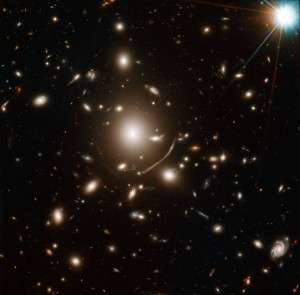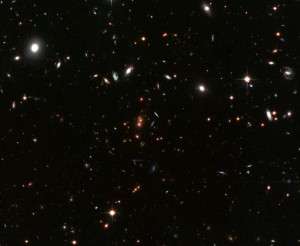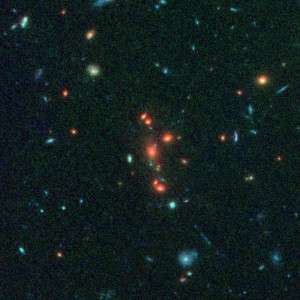Galaxies in the thick of it grow up fast

In a quest to learn more about our own galaxy, a Sydney astronomer has identified dozens of previously unknown galaxies in a distant cluster.
Using one of the world's largest optical telescopes, Dr Amanda Bauer—an ARC Super Science Fellow at the Australian Astronomical Observatory—and her team around the world have been studying this cluster closely. They have found that the galaxies close together in the crowded centre of the cluster mature faster than those in isolation on the cluster's outskirts.
"We are trying to find out why galaxies stop growing and mature, because this will tell us something about the ultimate fate of our own galaxy, the Milky Way," Amanda says.
A galaxy grows when it is forming new stars. Amanda is trying to find out what stops galaxies from doing this, therefore reaching maturity.
Distant galaxy clusters are relatively rare, she says. They are some of the first systems that formed after the Big Bang and represent the largest structures in the Universe held together by gravity.

"We have only recently been able to study them in detail. Using a new technique on the Gemini North Observatory telescope in Hawaii we were able to look at one particular galaxy cluster, where we identified dozens of new galaxies," Amanda said.
"The galaxies in clusters are slowly but constantly moving and evolving. We are trying to understand the influence that a galaxy's neighbourhood has on its fate."

The centre of the cluster is crowded with galactic neighbours in a sea of hot gas. The galaxies influence each other through gravitation, and the hot gas seems to put a brake on star formation.
To understand better how these crowded environments can enhance and then end the growth cycle of galaxies, Amanda and her team are now embarking on an Australian-based project to find new galaxies of varying levels of isolation.
The astronomers will combine existing data with observations from large telescopes in Hawaii and Chile and the Hubble Space Telescope. They hope their results will help them understand how the Milky Way Galaxy developed, and how it will interact in future with its galactic neighbours.
The Milky Way exists under the influence of the nearby Andromeda galaxy and two smaller galaxies, the Magellanic Clouds. These galaxies will eventually collide and merge.
"The current prediction is that this will happen in several billion years. Our research should tell us how long the resulting galactic system will form new stars before it settles into maturity."



















